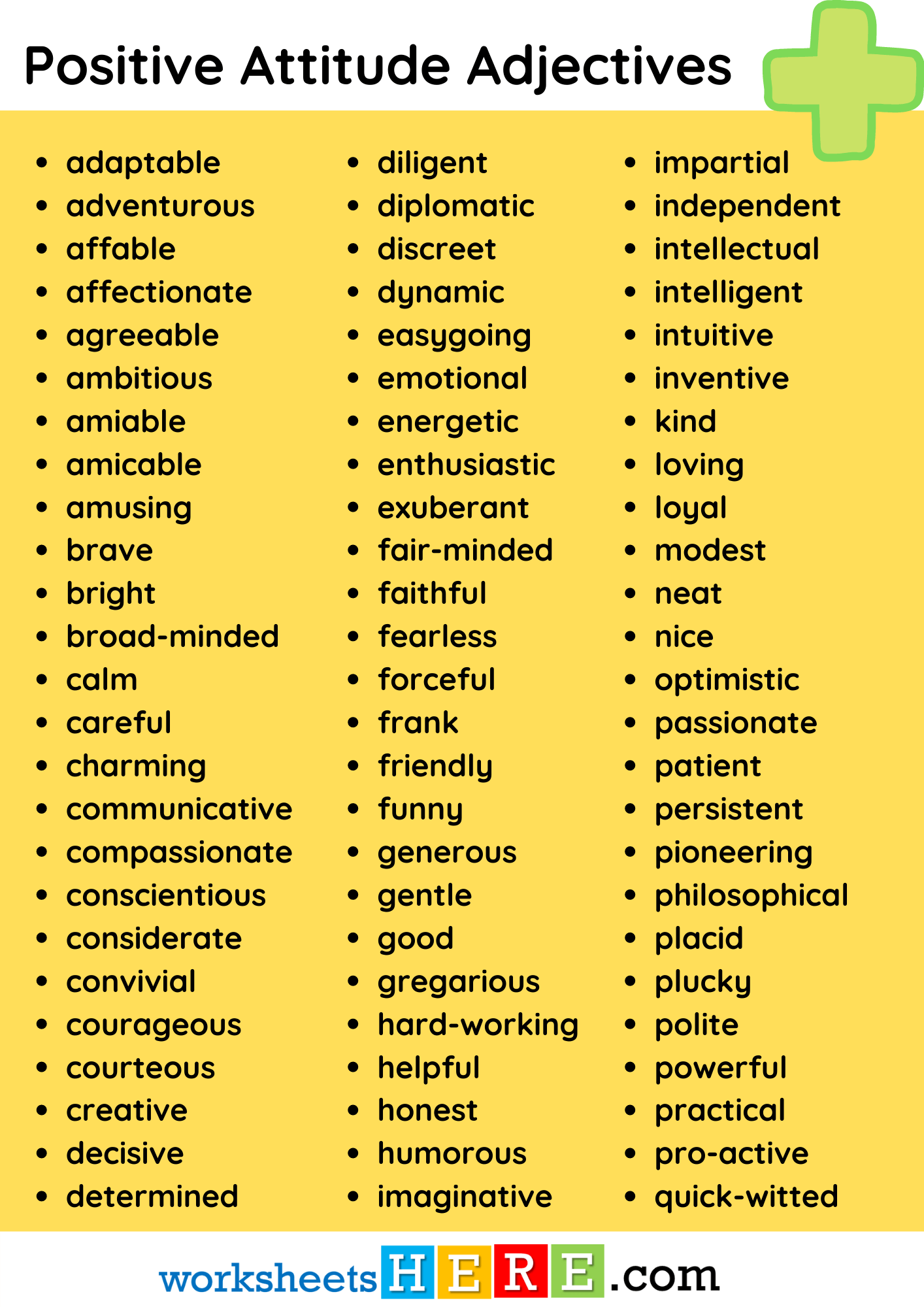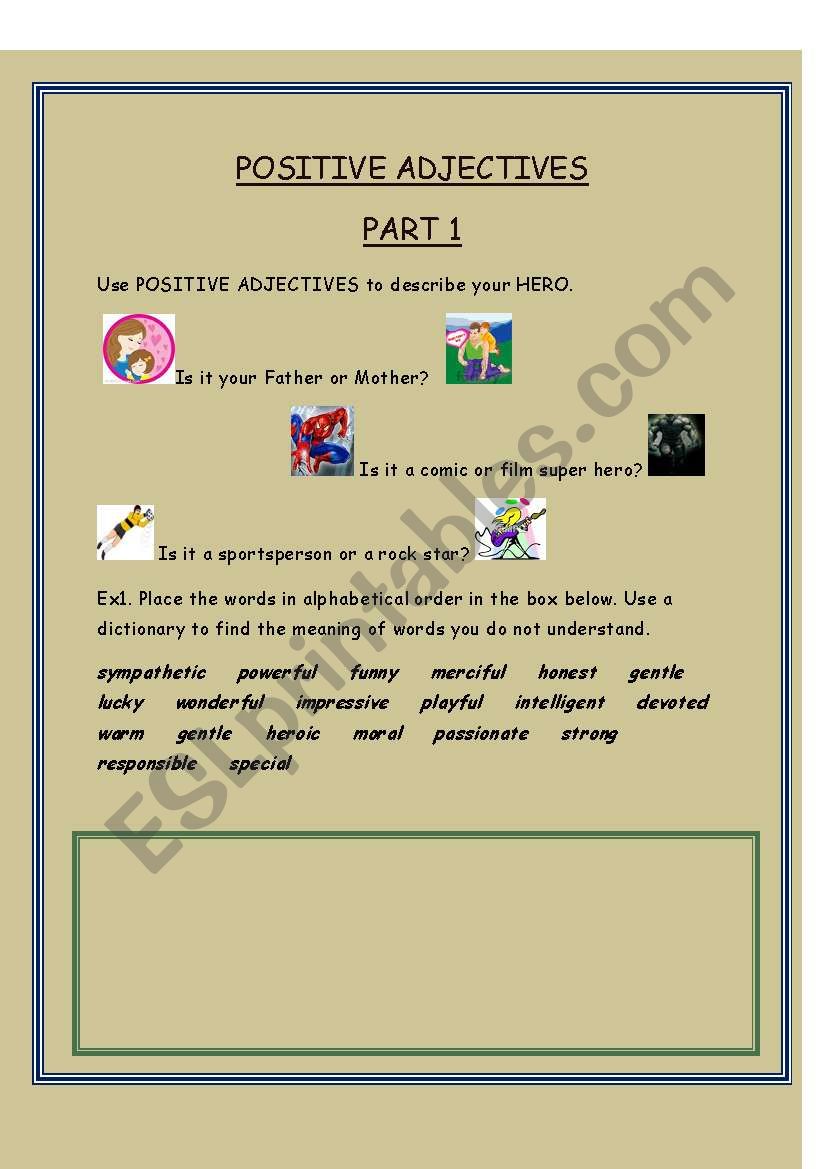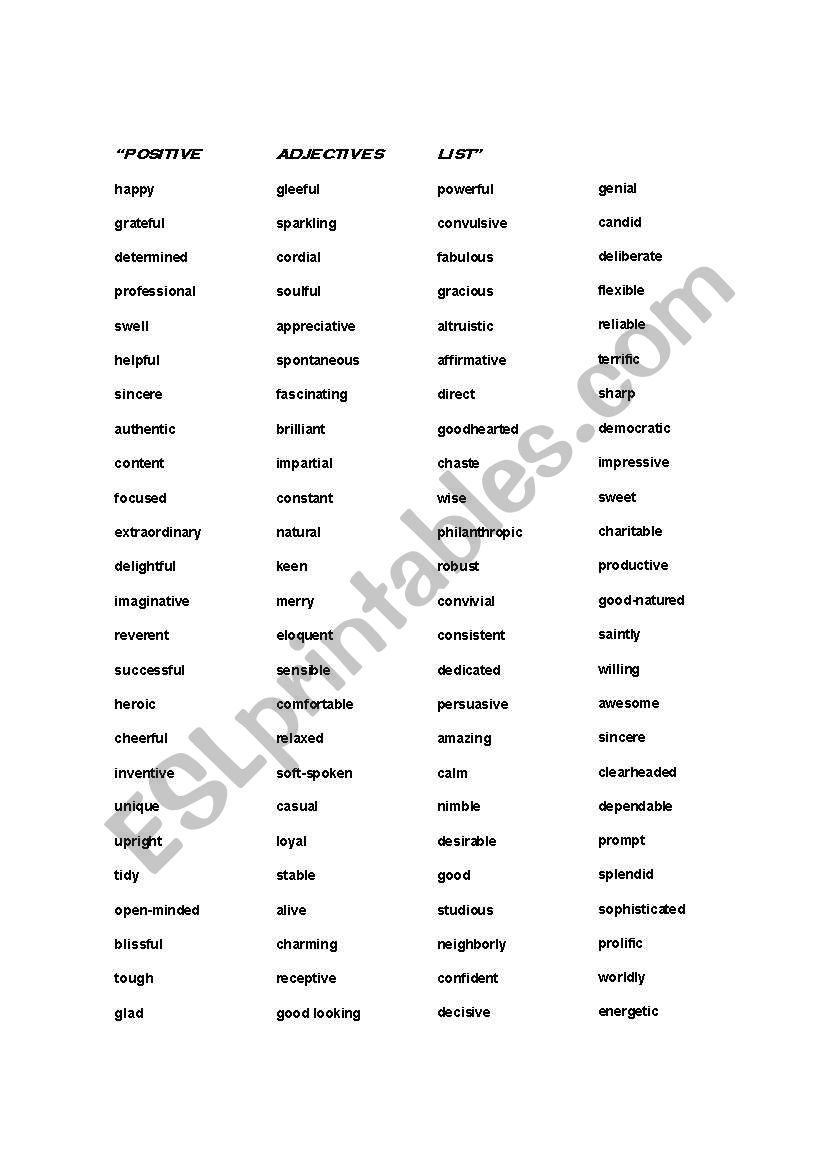
The Transformative Power of Language: Unlocking Potential with a Positive Adjectives Worksheet
Language is more than just a tool for communication; it’s a powerful force that shapes our perceptions, influences our emotions, and defines our reality. The words we choose, especially those we use to describe ourselves, others, and the world around us, hold immense power. In a world often saturated with negativity, intentionally cultivating a vocabulary of positive adjectives can be a transformative practice. This is where a well-crafted positive adjectives worksheet becomes an invaluable resource, offering a structured approach to expanding our linguistic toolkit and, consequently, our emotional and psychological well-being.
The Undeniable Influence of Positive Language
Before delving into the specifics of a positive adjectives worksheet, it’s crucial to understand why positive language matters so profoundly. Adjectives, by their very nature, add color, detail, and nuance to our descriptions. When these adjectives are positive, they elevate the subject, evoke favorable emotions, and foster a more optimistic outlook.

Consider the difference between describing a person as "okay" versus "remarkable," or a task as "difficult" versus "challenging." While seemingly subtle, these linguistic shifts can significantly alter how we perceive the person or the task, and in turn, how we respond to them. Positive language can:

- Boost Self-Esteem: When we describe ourselves using words like "capable," "resilient," or "courageous," we internalize these qualities, strengthening our self-belief.
- Improve Communication: Using positive adjectives in conversations can make feedback more constructive, compliments more genuine, and overall interactions more harmonious.
- Foster Stronger Relationships: Describing loved ones with words like "compassionate," "supportive," or "inspiring" not only affirms their value but also deepens your appreciation for them.
- Enhance Problem-Solving: Framing challenges with words like "solvable," "innovative," or "growth-oriented" can shift our mindset from despair to proactive solution-finding.
- Cultivate a Positive Mindset: Regularly engaging with positive vocabulary can rewire our brains to focus on strengths, opportunities, and gratitude, promoting overall mental wellness.



In essence, positive language is a cornerstone of emotional intelligence, effective communication, and personal growth. It empowers us to reframe our narratives, both internal and external, leading to a more fulfilling existence.

What is a Positive Adjectives Worksheet and Why is it Essential?
A positive adjectives worksheet is a structured learning tool designed to introduce, reinforce, and encourage the active use of adjectives that convey favorable, uplifting, or constructive qualities. It’s not merely a list of words; it’s an interactive guide that helps users integrate these words into their active vocabulary.

The essential nature of such a worksheet stems from the fact that while we intuitively understand the concept of positive words, we often default to a limited range in our daily speech and writing. A worksheet provides:
- Systematic Exposure: It exposes learners to a wide array of positive adjectives they might not regularly encounter or use.
- Contextual Understanding: Through exercises, it helps users understand the precise meaning and appropriate usage of each adjective in different contexts.
- Active Practice: It moves beyond passive reading to active application, which is crucial for embedding new vocabulary into long-term memory and daily habits.
- Self-Reflection Opportunities: Many worksheets incorporate prompts that encourage users to apply positive adjectives to their own lives, experiences, and self-perceptions.
- Versatility: A positive adjectives worksheet can be adapted for various age groups and purposes, from vocabulary building in schools to personal development in adults, or even as a tool in therapeutic settings for cognitive reframing.


Components of an Effective Positive Adjectives Worksheet
To be truly impactful, a positive adjectives worksheet should incorporate several key elements:
-
Curated Word Lists:
- Variety: Include adjectives describing personality (e.g., optimistic, empathetic, resilient), achievements (e.g., accomplished, brilliant, innovative), emotions (e.g., joyful, serene, inspired), and even sensory experiences (e.g., vibrant, soothing, magnificent).
- Categorization: Grouping words by theme (e.g., "Adjectives for Describing People," "Adjectives for Describing Experiences," "Adjectives for Describing Achievements") can make the list less overwhelming and more digestible.
- Graded Difficulty: For younger learners, start with simpler words and gradually introduce more complex ones.
-
Clear Definitions and Synonyms:
- Each adjective should be accompanied by a concise, easy-to-understand definition.
- Including a few synonyms can further expand the user’s vocabulary and understanding of nuances.
-
Contextual Example Sentences:
- This is vital. A word’s meaning becomes truly clear when seen in a sentence. For instance, instead of just "resilient," provide: "Despite numerous setbacks, her resilient spirit always found a way to bounce back."
-
Engaging Exercises:
- Matching: Match the adjective to its definition.
- Fill-in-the-Blanks: Provide sentences with a blank where the user must choose the most appropriate positive adjective from a given list.
- Sentence Construction: Ask users to write original sentences using specific positive adjectives.
- Descriptive Prompts: "Describe your best friend using at least three positive adjectives." "Describe a time you felt truly accomplished."
- Self-Reflection Questions: "What three positive adjectives would you use to describe your ideal self?" "How can you apply a more optimistic approach to your next challenge?"
- Story Writing/Paragraph Building: Challenge users to write a short paragraph or story incorporating a set number of positive adjectives.
- Opposites/Antonyms: For a deeper understanding, ask users to identify the opposite of a given positive adjective.
-
Application Prompts:
- Encourage users to think about how they can integrate these words into their daily conversations, journaling, or even self-talk.
Designing and Utilizing a Positive Adjectives Worksheet
Whether you’re an educator, a therapist, a parent, or simply an individual seeking personal growth, creating or selecting the right positive adjectives worksheet involves thoughtful consideration.
For Educators:
- Curriculum Integration: Use worksheets as part of language arts lessons on descriptive writing, character analysis, or even social-emotional learning.
- Differentiation: Create versions with varying levels of complexity to cater to diverse learning needs within a classroom.
- Collaborative Activities: Encourage students to work in pairs or small groups to complete exercises, fostering peer learning and discussion.
For Personal Development:
- Journaling Prompts: Use the adjectives as starting points for daily reflections. "Today, I want to embody courage and perseverance."
- Goal Setting: Frame goals using positive adjectives. "I will approach this project with an innovative and proactive mindset."
- Affirmations: Create personal affirmations using words from the worksheet. "I am capable, I am strong, I am worthy."
For Therapeutic Applications:
- Cognitive Behavioral Therapy (CBT): Help clients reframe negative self-talk by replacing self-deprecating adjectives with positive, realistic ones.
- Building Self-Esteem: Guide clients in identifying their strengths and positive qualities using a curated list of adjectives.
- Mindfulness: Encourage the mindful observation of positive attributes in their environment or in others.
Tips for Maximizing Effectiveness:
- Make it Fun: Incorporate games, visuals, or interactive elements, especially for younger learners.
- Consistency is Key: Regular, even short, engagement with the worksheet will yield better results than sporadic long sessions.
- Personalization: Encourage users to choose words that resonate most with them or are relevant to their current goals.
- Beyond the Worksheet: Remind users that the ultimate goal is to integrate these words into their natural speech and thought patterns. Encourage them to listen for positive adjectives in media, identify them in others, and consciously use them themselves.
The Long-Term Impact
The benefits of engaging with a positive adjectives worksheet extend far beyond simply expanding one’s vocabulary. It’s an investment in a more positive mindset, improved communication skills, and a richer internal dialogue. By consciously choosing to describe the world and ourselves in uplifting ways, we actively participate in creating a more optimistic and fulfilling reality.
In conclusion, the power of words is undeniable, and positive adjectives are the building blocks of empowering language. A well-designed and consistently utilized positive adjectives worksheet serves as a vital tool in cultivating this power, leading to enhanced self-perception, stronger relationships, and a more positive outlook on life’s myriad experiences. It’s a simple yet profound step towards transforming not just our language, but our very way of being.
